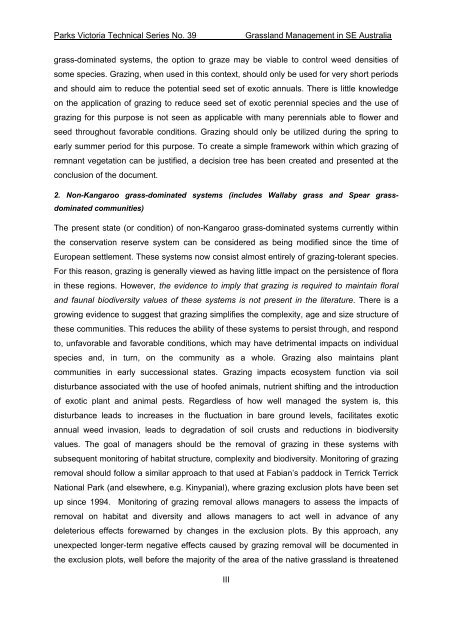Review of Grassland Management in south-eastern ... - Parks Victoria
Review of Grassland Management in south-eastern ... - Parks Victoria
Review of Grassland Management in south-eastern ... - Parks Victoria
You also want an ePaper? Increase the reach of your titles
YUMPU automatically turns print PDFs into web optimized ePapers that Google loves.
<strong>Parks</strong> <strong>Victoria</strong> Technical Series No. 39<br />
<strong>Grassland</strong> <strong>Management</strong> <strong>in</strong> SE Australia<br />
grass-dom<strong>in</strong>ated systems, the option to graze may be viable to control weed densities <strong>of</strong><br />
some species. Graz<strong>in</strong>g, when used <strong>in</strong> this context, should only be used for very short periods<br />
and should aim to reduce the potential seed set <strong>of</strong> exotic annuals. There is little knowledge<br />
on the application <strong>of</strong> graz<strong>in</strong>g to reduce seed set <strong>of</strong> exotic perennial species and the use <strong>of</strong><br />
graz<strong>in</strong>g for this purpose is not seen as applicable with many perennials able to flower and<br />
seed throughout favorable conditions. Graz<strong>in</strong>g should only be utilized dur<strong>in</strong>g the spr<strong>in</strong>g to<br />
early summer period for this purpose. To create a simple framework with<strong>in</strong> which graz<strong>in</strong>g <strong>of</strong><br />
remnant vegetation can be justified, a decision tree has been created and presented at the<br />
conclusion <strong>of</strong> the document.<br />
2. Non-Kangaroo grass-dom<strong>in</strong>ated systems (<strong>in</strong>cludes Wallaby grass and Spear grassdom<strong>in</strong>ated<br />
communities)<br />
The present state (or condition) <strong>of</strong> non-Kangaroo grass-dom<strong>in</strong>ated systems currently with<strong>in</strong><br />
the conservation reserve system can be considered as be<strong>in</strong>g modified s<strong>in</strong>ce the time <strong>of</strong><br />
European settlement. These systems now consist almost entirely <strong>of</strong> graz<strong>in</strong>g-tolerant species.<br />
For this reason, graz<strong>in</strong>g is generally viewed as hav<strong>in</strong>g little impact on the persistence <strong>of</strong> flora<br />
<strong>in</strong> these regions. However, the evidence to imply that graz<strong>in</strong>g is required to ma<strong>in</strong>ta<strong>in</strong> floral<br />
and faunal biodiversity values <strong>of</strong> these systems is not present <strong>in</strong> the literature. There is a<br />
grow<strong>in</strong>g evidence to suggest that graz<strong>in</strong>g simplifies the complexity, age and size structure <strong>of</strong><br />
these communities. This reduces the ability <strong>of</strong> these systems to persist through, and respond<br />
to, unfavorable and favorable conditions, which may have detrimental impacts on <strong>in</strong>dividual<br />
species and, <strong>in</strong> turn, on the community as a whole. Graz<strong>in</strong>g also ma<strong>in</strong>ta<strong>in</strong>s plant<br />
communities <strong>in</strong> early successional states. Graz<strong>in</strong>g impacts ecosystem function via soil<br />
disturbance associated with the use <strong>of</strong> ho<strong>of</strong>ed animals, nutrient shift<strong>in</strong>g and the <strong>in</strong>troduction<br />
<strong>of</strong> exotic plant and animal pests. Regardless <strong>of</strong> how well managed the system is, this<br />
disturbance leads to <strong>in</strong>creases <strong>in</strong> the fluctuation <strong>in</strong> bare ground levels, facilitates exotic<br />
annual weed <strong>in</strong>vasion, leads to degradation <strong>of</strong> soil crusts and reductions <strong>in</strong> biodiversity<br />
values. The goal <strong>of</strong> managers should be the removal <strong>of</strong> graz<strong>in</strong>g <strong>in</strong> these systems with<br />
subsequent monitor<strong>in</strong>g <strong>of</strong> habitat structure, complexity and biodiversity. Monitor<strong>in</strong>g <strong>of</strong> graz<strong>in</strong>g<br />
removal should follow a similar approach to that used at Fabian’s paddock <strong>in</strong> Terrick Terrick<br />
National Park (and elsewhere, e.g. K<strong>in</strong>ypanial), where graz<strong>in</strong>g exclusion plots have been set<br />
up s<strong>in</strong>ce 1994. Monitor<strong>in</strong>g <strong>of</strong> graz<strong>in</strong>g removal allows managers to assess the impacts <strong>of</strong><br />
removal on habitat and diversity and allows managers to act well <strong>in</strong> advance <strong>of</strong> any<br />
deleterious effects forewarned by changes <strong>in</strong> the exclusion plots. By this approach, any<br />
unexpected longer-term negative effects caused by graz<strong>in</strong>g removal will be documented <strong>in</strong><br />
the exclusion plots, well before the majority <strong>of</strong> the area <strong>of</strong> the native grassland is threatened<br />
III

















